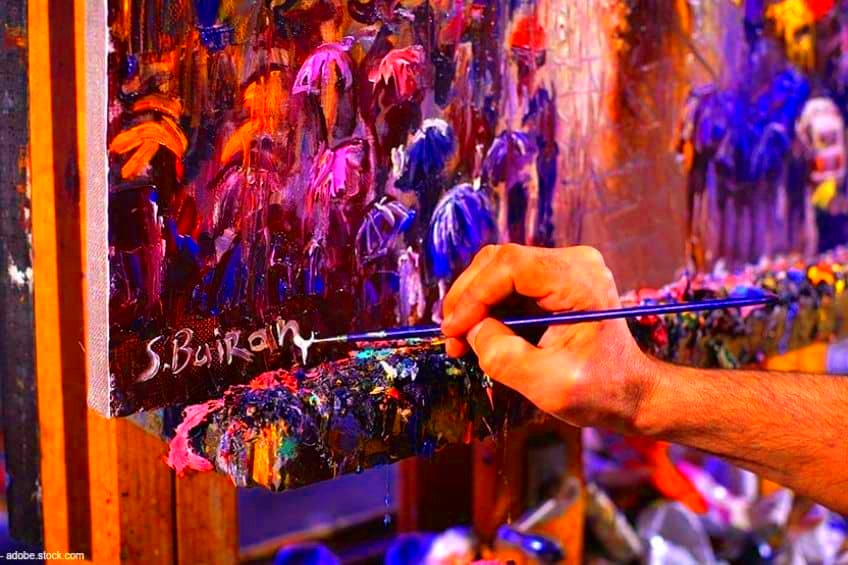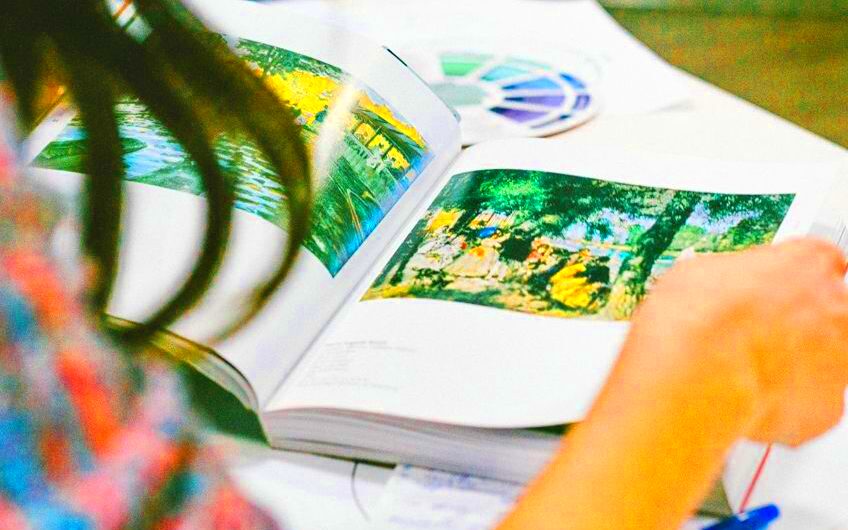Image attribution is crucial in the world of visual content. It acknowledges the artist's work and protects their rights. Proper attribution not only shows respect for the creator but also helps you avoid potential legal issues. When you use an image, it’s essential to credit the artist to promote their work and maintain ethical standards in content creation. In this section, we’ll explore why image attribution matters and how it can benefit both creators and users.
Common Methods to Identify Artists of Images

Identifying the artist behind an image can be challenging, but several methods can help you track down the creator. Here are some common approaches:
- Look for Watermarks: Many artists place watermarks on their images to protect their work. Check for any visible watermarks that might indicate the artist’s name or website.
- Check the Image Metadata: Metadata can contain useful information about the image, including the creator's name, copyright details, and more. Use software like Adobe Photoshop or online tools to access this data.
- Utilize Reverse Image Search: Platforms like Google Images allow you to upload the picture and find similar images online, which may lead you to the artist.
- Search on Social Media: Many artists showcase their work on social media platforms. Searching for the image on platforms like Instagram or Pinterest might yield results.
Also Read This: How to Download Free Images from Getty Images Legally
Using Reverse Image Search Tools Effectively
Reverse image search tools are powerful allies in discovering the artist behind an image. Here’s how to make the most of these tools:
- Choose the Right Tool: Google Images, TinEye, and Bing Visual Search are popular options. Each has unique features, so pick one that suits your needs.
- Upload or Paste the Image URL: You can either upload the image directly or paste the URL where the image is located.
- Review Search Results: The search results will show you where the image appears online. Look for links that may lead you to the artist’s portfolio or website.
- Check Similar Images: Many tools provide visually similar images, which can help you find related works by the same artist.
By following these steps, you can effectively utilize reverse image search tools to uncover the identity of the artist behind any image.
Also Read This: How to Upload Photos to Getty Images to Sell as a Photographer Submission Guide
Exploring Metadata to Find Artist Information
Metadata is like the hidden treasure of the digital world. When you find an image, it often comes with embedded information that can reveal the artist's identity, copyright details, and more. Understanding how to access and interpret this data can be incredibly useful. In this section, we’ll discuss how to explore image metadata to uncover artist information.
To access metadata, follow these steps:
- Use Image Editing Software: Programs like Adobe Photoshop, Lightroom, or even some free tools can help you access an image's metadata. Open the image and look for an option like "File Info" or "Properties."
- Online Metadata Viewers: If you don’t have image editing software, you can use online tools such as ExifTool or Jeffrey’s Image Metadata Viewer. Simply upload the image to these sites, and they’ll display the metadata.
Here’s what you might find in the metadata:
- Creator's Name: Many artists include their name or pseudonym.
- Copyright Notice: This indicates who owns the rights to the image.
- Creation Date: This can help you understand when the image was made, which might lead you to the artist’s active period.
- Camera Settings: While not directly related to the artist, this information can give insight into their techniques and style.
By exploring metadata, you can often piece together the identity of the artist and better understand their work.
Also Read This: How to Use GIMP to Crop an Image for Professional Editing
Checking Watermarks and Signatures on Images
Watermarks and signatures serve as a form of protection for artists, marking their work and asserting their ownership. Recognizing and understanding these marks can lead you to the artist behind an image. In this section, we’ll delve into how to check for watermarks and signatures effectively.
Here’s how to go about it:
- Examine the Image Carefully: Look for any text or logos embedded in the image. Watermarks can be placed in corners or subtly integrated into the artwork.
- Search for Signatures: Many artists sign their work, either visibly or discreetly. Check the image’s borders or areas that might naturally draw your eye.
- Use Zoom Features: If the watermark is faint, zooming in might help you read it better. This can provide clues about the artist or their website.
If you find a watermark or signature, it’s a good idea to search for the name or logo online. This can lead you directly to the artist's portfolio or social media profile. Remember, if you plan to use the image, respecting the copyright indicated by the watermark is essential.
Also Read This: How to Own a Stock with Adobe
Utilizing Social Media and Online Platforms for Artist Discovery
Social media is a fantastic resource for finding artists and their work. Platforms like Instagram, Pinterest, and Behance showcase countless artists sharing their creations. Leveraging these platforms can help you identify the creator of an image and connect with them. Let’s explore how to utilize social media effectively for artist discovery.
Here’s how to get started:
- Search Using Hashtags: Use relevant hashtags related to the image or style. For example, #Photography, #DigitalArt, or #Painting can lead you to artists who create similar works.
- Join Art Communities: Many platforms have dedicated groups or forums where artists share their work. Participating in these communities can help you find new artists and connect directly with them.
- Follow Artist Pages: Once you identify an artist, follow their page to stay updated on their work and future projects. This also helps you see their style and other creations.
- Use Visual Discovery Tools: Platforms like Pinterest allow you to search using images. You can find similar works or the original source by uploading an image.
By actively engaging on social media, you can not only find the artist of an image but also support their work and potentially collaborate with them in the future.
Also Read This: A Simple Guide to Posting Work in Progress (WIP) on Behance
Considering Licensing and Copyright Information
When using images, understanding licensing and copyright is essential to avoid legal troubles and respect artists' rights. Copyright protects creators by granting them exclusive rights over their work, including how it’s used, shared, and distributed. Licensing is the way artists allow others to use their images, usually under specific conditions. In this section, we’ll dive into the importance of these concepts and how to navigate them.
Here are a few key points to consider regarding licensing and copyright:
- Types of Licenses: There are various types of licenses, including Creative Commons, royalty-free, and rights-managed. Each comes with different rules about how the image can be used. Always read the terms carefully.
- Check for Copyright Notices: Look for any copyright information accompanying the image. This may include the artist's name and year of creation, which indicates who holds the rights.
- Understand Fair Use: Fair use allows limited use of copyrighted material without permission under certain circumstances, such as criticism, comment, news reporting, and education. However, it’s important to know the limits.
- Request Permission: If you're unsure about using an image, reaching out to the artist for permission is always a good idea. Most artists appreciate being asked and may grant you the rights you need.
By being mindful of licensing and copyright information, you can use images responsibly while respecting the artists behind them.
Also Read This: Are iStock Photos Royalty Free
Frequently Asked Questions
In this section, we’ll address some common questions people have about discovering artists of images, copyright, and related topics. Whether you're a content creator, a marketer, or just someone curious about art, these FAQs can help clarify your doubts.
- What should I do if I can’t find the artist’s name? If you can’t find the artist through reverse image searches or metadata, try reaching out to online communities or forums that focus on art. Someone may recognize the work.
- Can I use an image without permission? Using an image without permission can lead to copyright infringement, which is illegal. Always check the licensing terms and seek permission if needed.
- What is the difference between copyright and licensing? Copyright protects the creator’s rights, while licensing allows others to use the work under specific conditions. Understanding both is vital for responsible image use.
- Are there free resources for finding images? Yes! Websites like Unsplash, Pexels, and Pixabay offer free images, often under Creative Commons licenses. Just make sure to read the usage guidelines.
These FAQs can help guide you in your journey to understanding image attribution and artist discovery.
Conclusion and Key Takeaways
In conclusion, finding the artist of an image involves a mix of techniques, tools, and a good understanding of copyright and licensing. Whether you're a creator looking for inspiration or someone simply wanting to credit the right artist, knowing how to navigate this landscape is crucial. Here are some key takeaways:
- Always attribute the artist: Proper attribution shows respect and can help avoid legal issues.
- Utilize available tools: Reverse image search, metadata, and social media are invaluable resources for identifying artists.
- Understand copyright and licensing: Knowing the rules helps you use images ethically and legally.
- Engage with the community: Connect with artists and other enthusiasts to share knowledge and resources.
By following these guidelines, you can enjoy and share images while honoring the talented creators behind them. Happy exploring!

 admin
admin








